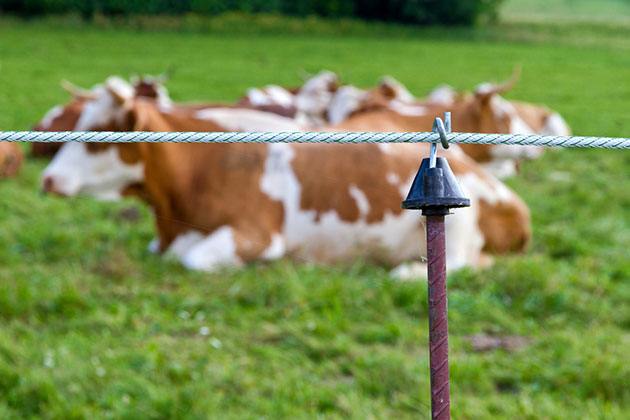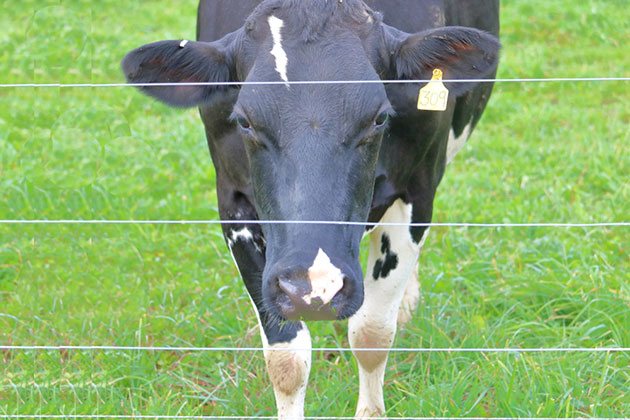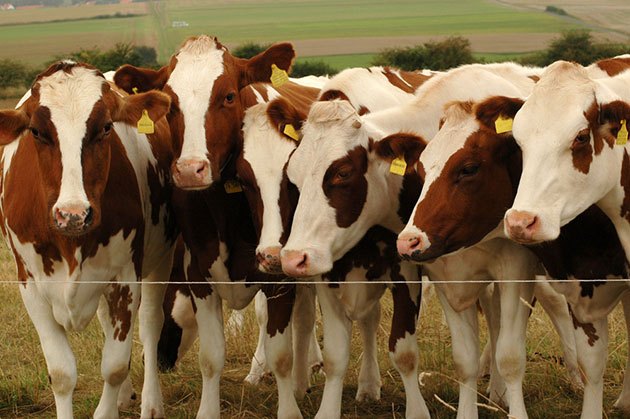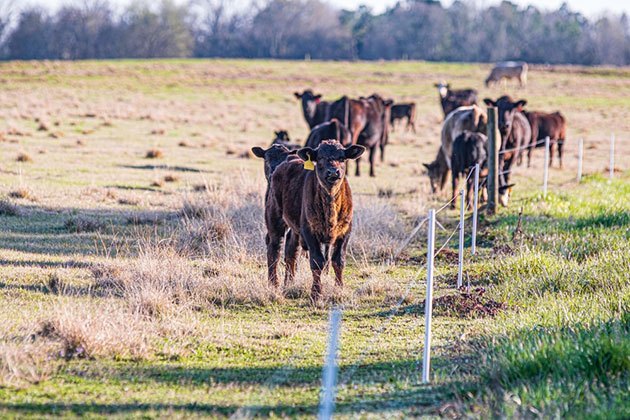An electric fence for cows and cattle is entirely safe!
Many owners doubt the well-being of their cattle and animals, once the electric fencing has been installed, but with proper equipment and knowledge, there is no need for worrying!
By installing electric fencing for cows and beef cattle, you will ensure they stay within the pasture area, prevent the mixing of breeding and non-breeding cows, and keep the predators out.
To build the fencing for dairy cows, you will need more than just wires and an energizer.
The best way to prepare is by acquiring knowledge of cow behavior to teach them to respect the fence effectively.
How Well Do You Know Cows?

Cows, often referred to as cattle, are among the largest domesticated animals.
They differed in temperament, but the majority exhibited standard behavior patterns and positively responded to herd management.
They are often called “creatures of habit,” meaning they adjust to their daily routines and react to sudden changes.
Therefore, training a young calf to respect electric fencing may be easier.
They will take the lesson into adulthood, which is far more beneficial than teaching an older cow to respect fence boundaries.
Cattle rely on their instinct the most. Therefore, a sensory behavior of a cow is determined by what they hear, smell, taste, see, or feel in its environment.
Due to the conditioned learning experience, dairy cows are one of the most grateful animals to train around the electric fencing.
The animal is not known for their escape skills, so once they learn how to behave within the fencing area, they are less likely to try to escape.
However, they often scratch and wiggle on the posts so getting electric fencing is the best solution to keeping it in place.
Electric Fencing for Cows: Hit or Miss?
Electric fencing is an excellent way of keeping your cattle inside the pasture area. However, electric fences should present mental barriers rather than physical ones.
If you train your livestock and cattle to respect the fence, you will have no behavior problems. An electric fence designed explicitly for cows and calves is an economical and safe solution.
Unlike popularly used dangerous barbed wire fencing, an electric fence is a safer alternative.
Regular barbed wire can easily be a safety hazard, not only to dairy cows but also to other animals. If you are worried about whether the electric fence will harm the cow, the answer is no.
A slight shock of electricity will only be a lesson to them, not a trauma.
Remember, the aim is not to traumatize the animals but rather to teach them to stay within the pasture.
Cows quickly learn all they are trained to do, so you can safely know where your cattle are at all times!
What Is the Best Electric Fence & Wire for Cattle?

The best fence wire for cattle fencing is a high tensile wire.
Although many owners opt for a poly wire or barb wire, a high tensile one is a far better and safer alternative for electric fencing.
A high tensile wire is made from galvanized materials that
It can be stretched and adjusted to fit various electric fence options.
Since we are on electric fence options, one of the best choices is permanent fences. Unlike portable fence systems, they require more maintenance, but they are far more durable.
A permanent electric fence line needs a corrosion-resistant wire that can effectively transfer power.
You can decide on how many wires you want in the fencing.
The bottom wire should measure 55 cm from the ground. A top wire needs to be at least 125 cm.
If your livestock includes keeping bulls, you need to install a fence at least 152 cm high.
It can efficiently protect the bulls from the surroundings while keeping the entire permanent fencing system stable.
How to Design the Electric Fence for Cows?
You can either have a permanent electric fence or portable fence systems that can easily be relocated for starters.
So, based on your fence preference, you can make further construction plans.
There are numerous ways to construct a good fence, but here are a few steps you can follow.
Make sure you properly clear out the area for the electric fence. You don’t want any grass debris or weed around the fence line as it can often interrupt the electric charge.
Next, you should install the fence posts.
Using a digger, dig a hole for step-in posts or permanent fence posts.
Installing a fence gate is also crucial! Many owners often forget to add a gate before the fence is finished.
Posts need to be dug deep into the ground. The posts should be at least 100 feet away.
Gates are often better installed on the corner posts, not in the middle of the electric fence for cattle.
After the gate installation, attach the high tensile wire by using insulators to wire the gate.
It would be best if you also remembered not to pull on the wires too tightly.
Every second high tensile wire installed should be connected to the energizer to deliver enough voltage. The remaining wires should be used for the grounding system.
After the wire connection, install the ground rods and check the voltage of the electric fencing.
The bare minimum would be around 3,000V. If you have less than that, you will need to install more ground rods.

Electrical Equipment for Cattle Fencing
Only shop from trustworthy buyers.
This equipment for your existing fences or those you will build will often have to endure challenging weather.
With that being said, you will need:
1. Energizer – with the help of the energizer, the energy is converted from battery power to a high voltage pulse. When purchasing a new energizer, you should always opt for a bigger one.
With the bigger energizer, it’s sure that enough voltage passes through the wires, even in wet grass conditions.
Around 4000 volts are suitable for the wintertime, while for summer you want around 2000.
As animals shed coats more during summer, it’s logical they will require less voltage to feel the mild shock with electrified wire.
2. Insulators – Insulators are installed one per wire. Additionally, you will need to secure the insulators on the existing fences post.
3. Ground rods – Commonly, you will need around 1.8.-2.4 meters of ground rods to ensure enough power in the wires.
Extra tip: install a lightning rod to prevent unexpected mishaps on the post.
Is Solar Panel a Good Idea for Electric Fence for Cattle?

When building electric fencing for beef cattle and other animals, many farm owners wonder whether they should turn to a more economical power solution.
Solar panel chargers are an excellent and long-lasting alternative to electric chargers. You don’t have to worry about the cattle’s safety with them during a blackout.
Plus, they are a good choice for remote areas that don’t have a power grid nearby.
However, the only downside to solar energizers is that they are only suitable during summertime.
You will need to take advantage of the high noon sun to get the proper electric charge.
Final Words
An electric fence for cows is a proper solution for training cattle to respect the pasture enclosure boundaries.
Between electric and non-electric fencing, we would always opt for the first!
It requires less maintenance and is a safe, long-lasting alternative system for livestock and cattle.
Additionally, the fence is beneficial in preventing the cows from rubbing on the posts.
With the help of proper equipment such as high tensile wires, permanent fencing posts, and a high energizer, your farm animals will be protected in the best way possible.

